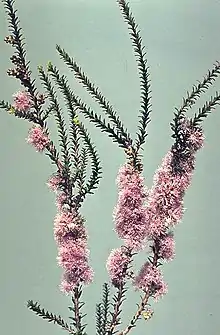| Melaleuca depauperata | |
|---|---|
 | |
| Scientific classification | |
| Kingdom: | Plantae |
| Clade: | Tracheophytes |
| Clade: | Angiosperms |
| Clade: | Eudicots |
| Clade: | Rosids |
| Order: | Myrtales |
| Family: | Myrtaceae |
| Genus: | Melaleuca |
| Species: | M. depauperata |
| Binomial name | |
| Melaleuca depauperata | |
| Synonyms[1] | |
Melaleuca depauperata is a shrub in the myrtle family, Myrtaceae and is endemic to the south-west of Western Australia. It has small, fleshy leaves and purple to pink flowers on short stalks along the branches.
Description
Melaleuca depauperata is dense, bushy, spreading shrub growing to about 2 m (7 ft) high and wide with fibrous bark. Its leaves are arranged alternately around the stem and are 1.8–5 mm (0.07–0.2 in) long and 1.0–3.0 mm (0.04–0.1 in) wide, flat but rather fleshy and oval shaped, usually with a blunt end but sometimes with a sharp point.
The flowers are mauve, pink or violet in spikes of between 4 and 17 individual flowers which fade to white as they age. The spikes are in the leaf axils, have a short stalk and are about 15 mm (0.6 in) in diameter. Flowering occurs from September to January but mainly between October and November. The fruit are almost spherical woody capsules 3.4 mm (0.1 in) long in loose clusters.[2][3]
Taxonomy and naming
This species was first formally described in 1852 by the Russian botanist Nikolai Turczaninow in Bulletin de la Classe physico-mathématique de l'Académie impériale des sciences de Saint-Pétersbourg.[4][5] The specific epithet (depauperata) is from the Latin depauperatus, possibly referring to the type specimen having few flowers.[3]
Distribution and habitat
Melaleuca depauperata occurs inland from the Stirling Range as far as Wagin and eastwards as far as Muntadgin and the Peak Charles National Park[3] in the Avon Wheatbelt, Coolgardie, Esperance Plains and Mallee biogeographic regions.[6] It grows on sandy and clayey soils on flats and roadsides.[7]
Conservation status
Melaleuca depauperata is listed as "not threatened" by the Government of Western Australia Department of Parks and Wildlife.[6]
References
- 1 2 "Melaleuca depauperata". Plants of the World Online. Retrieved 28 August 2021.
- ↑ Holliday, Ivan (2004). Melaleucas : a field and garden guide (2nd ed.). Frenchs Forest, N.S.W.: Reed New Holland Publishers. pp. 90–91. ISBN 1876334983.
- 1 2 3 Brophy, Joseph J.; Craven, Lyndley A.; Doran, John C. (2013). Melaleucas : their botany, essential oils and uses. Canberra: Australian Centre for International Agricultural Research. p. 146. ISBN 9781922137517.
- ↑ "Melaleuca depauperata". APNI. Retrieved 27 March 2015.
- ↑ Turczaninow, Nikolai (1852). "Melaleuca depauperata". Bulletin de la Classe physico-mathématique de l'Académie impériale des sciences de Saint-Pétersbourg. 10: 343. Retrieved 27 March 2015.
- 1 2 "Melaleuca depauperata". FloraBase. Western Australian Government Department of Biodiversity, Conservation and Attractions.
- ↑ Paczkowska, Grazyna; Chapman, Alex R. (2000). The Western Australian flora : a descriptive catalogue. Perth: Wildflower Society of Western Australia. p. 393. ISBN 0646402439.